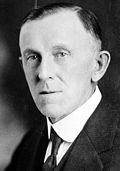November 4, 1924 | |||||||||||||||||||||||||||||||||||||
| |||||||||||||||||||||||||||||||||||||
 County results Gunderson: 30–40% 40–50% 50–60% 60–70% 70–80% 80–90% >90% Bulow: 40–50% 60–70% Putnam: 40–50% | |||||||||||||||||||||||||||||||||||||
| |||||||||||||||||||||||||||||||||||||
| Elections in South Dakota |
|---|
 |
The 1924 South Dakota gubernatorial election was held on November 4, 1924. Incumbent Republican Governor William H. McMaster declined to run for re-election to a third term, instead opting to run for the U.S. Senate. Lieutenant Governor Carl Gunderson won the Republican primary unopposed. In the general election, he faced three prominent opponents: Democratic nominee William J. Bulow, a former State Senator and Mayor of Beresford; Farmer–Labor nominee A. L. Putnam; and perennial candidate Richard O. Richards. Gunderson. Gunderson won the election in a landslide.

